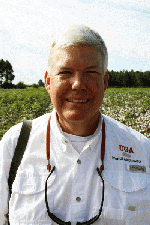March 1, 2016

Early in my career as an Extension specialist, I was asked by a county agent to visit a Mennonite farmer and to address an emerging problem in his corn crop. Upon arrival, I diagnosed the early stages of “northern corn leaf blight” and related that the grower had two options.

Bob Kemerait
He could do nothing, hoping that the disease would not progress or affect yield. He could also hire an aerial applicator and apply a fungicide to protect from further disease spread. I was torn in my recommendation, respecting the importance of the disease yet questioning the need for the expense of the plane and the fungicide. In the end, based upon the weather and my experience with northern corn leaf blight, I recommended that the grower save his money and not apply a fungicide. The farmer shook my hand, thanked me for the recommendation and agreed to follow my instructions.
Not too long after that, the agent called me again to say that he had visited the Mennonite farm and that the disease had exploded. The grower estimated the disease had cost him as much as 100 bu/A in yield. In developing my recommendation, I had factored in the weather, my experience with the disease and the expense that applying a fungicide would incur. Looking back, I should have also carefully considered the susceptibility of the corn variety. My well-intentioned desire not to “waste” the farmer’s money ended up costing him much more than I had saved him.
I returned somewhat fearfully to the field to survey the damage and to admit that my recommendation had not been the best. The farmer met me with courtesy and understanding and, while clearly disappointed, did not cast blame on me. As I got back in my truck and left, I was filled with appreciation for his kindness and was thankful for his Mennonite upbringing. I was sure that had the farmer been a Catholic like me, things would have ended much less cordially.
When it comes to diseases and plant-parasitic nematodes, Extension specialists and agents offer three main services to growers: We provide education so that farmers can improve their crop production. We diagnose disease and nematode problems so that they can seek an appropriate remedy. Lastly, we make “non-biased, research-based” recommendations to growers so that they can better manage the problems affecting their crops.
While often challenging, our educational background and in-service trainings upon entering Cooperative Extension should have prepared us to stand and deliver informative, timely programming and to diagnosis plant diseases based upon symptoms and signs of the pathogen. However, recommending to a grower the most appropriate disease management tactic to deploy or best product to use is often much more difficult.
Finding more ways to spend farmers' money?
Making effective disease and nematode management recommendations requires not only a timely diagnosis but also the ability to carefully discriminate among the solutions that are available. Giving a best answer (and often there is not a single “best” answer) requires a careful balance of the cost of management against the expected outcome, whether it is increased yield, quality or other factor adding value to the crop. To provide the best recommendation requires experience and confidence. Knowing that a grower is prepared to spend a “pile” of money based upon what you tell him can be unnerving, especially early in one’s career.
Confidence is also needed to look a producer in the eye and to say he or she is better off not throwing any more money and resources at a problem because the disease has progressed to such an extent that nothing will fix it. Ice water flows freely in my veins when standing in a field with a producer and an industry representative to explain why a disease or nematode problem has caused significant losses. At such times I know nothing I say will bring the crop back and that one of the two standing with me will leave disappointed and even angry.
Two seasons ago, a very successful corn, soybean and peanut grower in eastern Georgia chided me that since I arrived at the University of Georgia in 2000, recommendations for the use of fungicides on all of his crops, and also cotton, had increased dramatically. Though half joking, his point was that in an era where reducing costs was critical for staying “on the farm,” I seemed to be finding more and more ways to spend HIS money.
Looking back over 16 years in Georgia’s fields, it is apparent to me that where my recommendations have been less effective typically occurs when I am timid about the cost of a fungicide application. Today, more than ever, judicious use of fungicides and nematicides is critical for success in farming (unless one practices organic farming, of course). Our yield expectations are much more than they were 16 years ago. We have new diseases in Georgia and we have improved fungicides that better manage diseases and at lower use-rates. Use of fungicides and nematicides is an important way growers can “stay on the farm.”
I am happy to report that Mennonite farmer who showed such patience to me many years ago is doing well, though he may not be growing as much corn as he once did. Making disease and nematode management recommendations is never easier than it was sitting in the classroom back in college, going over textbook examples. But there is little that we do in Extension that is more important.
You May Also Like




